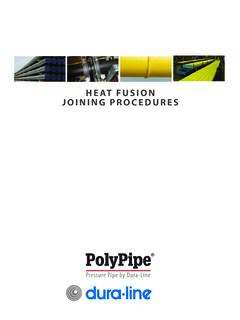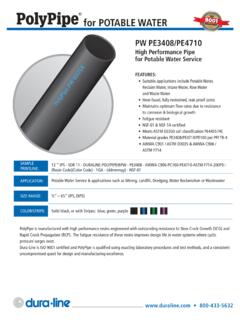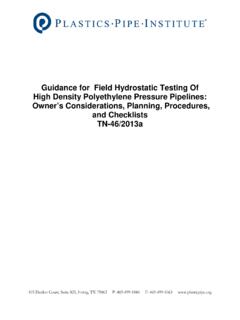Transcription of HDPE Pipe Pressure Rating Temperature Guidelines
1 Bulletin: PP 816-TN August 2007 Supersedes all previous publications Page 1 of 7 2007 Chevron Phillips Chemical Company LP Performance pipe , a division of PO Box 269006 Phone: 800-527-0662 Chevron Phillips Chemical Company LP Plano, TX 75026-9066 Fax: 972-599-7348 Note PP 816-TN PE3608 & PE4710 Materials Designation Codes and pipe Pressure Ratings Since introducing polyethylene pipe resin in the 1950 s, polyethylene (PE) manufacturers have worked continually to improve the material s performance. These improvements have resulted in a continual improvement from PE1404 materials to the current materials today referred to as PE4710 materials. Two of the most important characteristics for pipe material are resistance to long-term hydrostatic Pressure and resistance to slow crack growth development under localized stresses.
2 Testing protocols have been developed, improved, and standardized so that end users can be confident in getting the highest performance properties available from today s materials. Recent improvements in resin have been so significant that the resin classification system was changed to recognize and categorize higher properties for these newer materials. For instance, the term pe3408 is widely recognized however materials that were formerly classified as pe3408 are now split into three categories, pe3408 , PE3608 or PE4710. PE4710 pipes offer higher service pressures or reduced wall thicknesses, increased hydraulic capacity and better overall mechanical properties than the former pe3408 pipes. The trade off in all of this is that PE4710 material has a more complex molecular structure and thus costs more for resin manufacturers to make, but the net result is generally a savings on the per foot pipe cost.
3 New Cell Classification The ASTM D3350, Standard Specification for Polyethylene plastics pipe and Fittings Materials standard cell classification uses a series of digits to identify various properties of polyethylene pipe materials. For example, the cell classification for Performance pipe s standard extra high molecular weight pipe grade resin for municipal and industrial (M&I) applications is 345464C. In December 2005 ASTM changed this standard to expand the cell classification system. The 2005 change adds new limits to the base resin density cell. The density cell is the very first digit in the cell classification sequence. The changes essentially split the high density cell class into two categories; those with densities ranging from > g/cc3 to g/cc3 and those with densities ranging from > g/cc3 to g/cc3.
4 Prior to the split the density code for high density was 3 . After the split, the density code was left at 3 for the lower range of densities and changed to 4 for the higher range of densities. See Table 1. In addition to the density change, D3350 also recognized higher slow crack growth resistance, which is designated by the fifth digit in the cell classification. By the nineties, PE materials had improved so much that the standard environmental stress crack test, ASTM D 1693, was unable to differentiate between better performing materials. Researchers at the University of Pennsylvania developed an extremely rigorous slow crack growth test referred to as the PENT test. ASTM wrote a standard for this test, ASTM D 1473.
5 It was incorporated into D3350. At that time, the highest category in D3350 for the PENT test was a minimum test time of 100 hours. This performance was assigned a digit of 6 . In the 2005, ASTM added a new class with a minimum PENT test time of 500 hours. The new designation code is 7 . The University of Pennsylvania researchers early on concluded that one hour of PENT roughly equated to 13 years of service life.[1] While that analysis may be limited it does illustrate the tremendous slow crack growth resistance of the newer materials. Bulletin: PP 816-TN August 2007 Supersedes all previous publications Page 2 of 7 2007 Chevron Phillips Chemical Company LP Performance pipe , a division of PO Box 269006 Phone: 800-527-0662 Chevron Phillips Chemical Company LP Plano, TX 75026-9066 Fax: 972-599-7348 The PENT test, like D1693, has limitations.
6 While PENT may be useful as an indexing test, there is no accepted industry standard that assigns higher performance to materials with PENT higher than 500 hours. This is logical since it is observed that as the PENT time to failure increases the failure mode shifts from slow crack growth to tensile rupture, thus rendering the test questionable as an indicator of pipe long-term performance. See Krishnaswamy et al.[2] As a result of the additions to D3350, the newest material, PE4710, is identified by the cell classification, 445474C and highlighted in Table 1. Table 1. pipe Properties and Cell Class Limits per ASTM D3350-05 Property Test Method 0 1 2 3 4 5 6 7 8 1. Density, gm/cm3 D1505 a or lower > > > > -- b 2.
7 Melt Index D1238 a > to < to < c -- b 3. Flexural Modulus, psi D790 a <20,000 20,000 to <40,000 40,000 to <80,000 80,000 to <110,000 110,000 to <160,000 >160,000 b 4. Tensile Strength at Yield, psi D638 a <2200 2200 to <2600 2600 to <3000 3000 to <3500 3500 to <4000 >4000 b 5. Slow Crack Growth Resistance I. ESCR a. Test condition (100% Igepal) duration, h c. Failure,max,% D1693 a a A 48 50 B 24 50 C 192 20 C 600 20 b II. PENT (hours) Molded Plaque. 80OC, MPa Notch depth. F1473. Table 1 F1473 a a 10 30 100 500 b 6. Hydrostatic Strength Classification I. Hydrostatic design basis, psi (23oC) II. Minimum required strength, MPa (psi) (20OC) D2837 ISO 12162 d 800 1000 1250 1600 8 (1160) 10 (1450) Notes: (a) Unspecified.
8 (b) Specify Value. (c) Refer to ASTM D3350 Section (d) Not Pressure Rated. Higher Performance Material What are the implications of the higher density and higher PENT values on the performance of pipe made of this new material? The new materials have improved long term performance under hydrostatic stress. pipe made from these materials is suitable to operate at higher hoop stresses than pipe made from lower cell class materials. ASTM does not assign hydrostatic strength ratings to pipe material. This is done by the plastics pipe Institute (PPI). Concurrent with the changes in D3350, the PPI assigned higher hydrostatic strength ratings for materials that met a minimum of 500 hours of PENT and certain additional material requirements.
9 Bulletin: PP 816-TN August 2007 Supersedes all previous publications Page 3 of 7 2007 Chevron Phillips Chemical Company LP Performance pipe , a division of PO Box 269006 Phone: 800-527-0662 Chevron Phillips Chemical Company LP Plano, TX 75026-9066 Fax: 972-599-7348 Rating PE Materials To understand those requirements a little background in how materials are Pressure rated is helpful. The recognized method for determining the long-term performance of thermoplastic materials is ASTM D 2837, Obtaining Hydrostatic Design Basis for Thermoplastic pipe Materials . PPI s Technical Report 3 (TR-3) describes the methodology for establishing a pipe material s hydrostatic design basis. The hydrostatic design basis, HDB, for a thermoplastic materials is the long-term hoop tensile stress that the material can be expected to withstand for 100,000 hours at a specific Temperature .
10 Supplemental validation at elevated temperatures verifies long term performance against failure by cracking. Technical Report 4 (TR-4) lists the HDB as well as the recommended maximum hydrostatic design stress (HDS) in water service at various temperatures for listed thermoplastic materials. This information is available at Until 2006, the highest HDS at 73oF assigned to any high density polyethylene material was 800 psi. Once the new cell classification was available in D3350, PPI approved new criteria for resins that would allow higher HDS values at 73oF. The new criteria included a minimum PENT value of 500 hours, a stress rupture curve with tighter data scatter requirements, and validation of the linearity of the stress rupture curve for 50 years.





